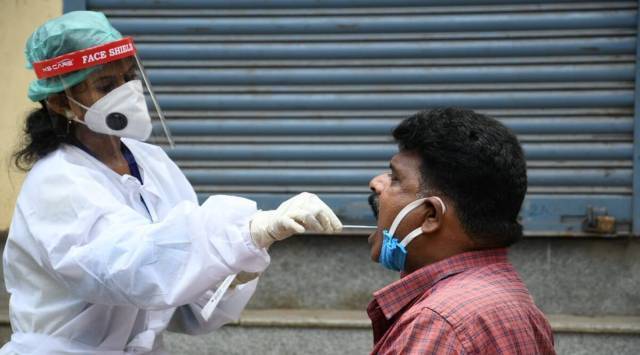 XBB.1.16 is emerging as the dominant strain as it has two extra spike mutations over and above XBB.1.5, which is one of the most transmissible variant in recent times, said Dr Karyakarte. (Express Photo)
XBB.1.16 is emerging as the dominant strain as it has two extra spike mutations over and above XBB.1.5, which is one of the most transmissible variant in recent times, said Dr Karyakarte. (Express Photo) With World Health Organisation (WHO) monitoring Omicron XBB.1.16 subvariant that has largely been documented in India, Dr Rajesh Karyakarte, Maharashtra coordinator for genome sequencing, said it was due to whole genome sequencing (WCG) of Covid positive samples that the infection could be detected at an early stage in the country.
When cases were low, getting Covid positive samples was a challenge at laboratories like B J Medical College (BJMC), Pune, and Indian Council of Medical Research-National Institute of Virology (NIV). However, these institutions were engaged in WCG of the limited number of samples they got as a result of which teams from Maharashtra were able to alert both the state and the Centre on March 10 when the subvariant was identified for the first time in the country, Dr Karyakarte said.
With the increase in the number of samples for genome sequencing, Dr Karyakarte said, Pune-CoG — a consortium of five Indian SARS-CoV2 Genomics Consortium (INSACOG) labs in the city — will be activated. Apart from NIV and BJMC, the other three labs include National Centre for Cell Science, National Chemical Laboratory, and Indian Institute of Science Education and Research.
XBB.1.16 is emerging as the dominant strain as it has two extra spike mutations over and above XBB.1.5, which is one of the most transmissible variant in recent times, said Dr Karyakarte. “These extra spike mutations are S:E180V and S:K478R. So, this mutation gives added immune escape,” he added. The immune escape property and increased transmission rate gives a relative growth advantage to XBB.1.16 that helps it become the dominant variant, the expert added. These numbers are bound to change with increased sequencing, he said.
Meanwhile, preliminary findings of clinical and epidemiological profiling study of XBB.1.16 among 42 patients have been submitted to the government. The symptoms are mild and the study is now being extended to include more patients. “At the state health department, officials have issued advisories. Apart from tracking hospital admissions, we are also keeping a close watch on any rise in the demand for oxygen,” said Dr Karyakarte.
How a team from BJMC first identified XBB.1.16
“Throughout the pandemic, we have seen that…a new wave/surge is not caused by the same unmutated variant,” said Dr Karyakarte. “After sequencing positive samples during this surge, we found XBB, XBB.1 and XBB.1.5 in large proportions. This was not as per the trend mentioned previously. We found references of the newly named variant XBB.1.16 on GitHub on the cov-lineages/pango-designation page. The important information mentioned there was that it is isolated from patients with a recent history of travel to India,” he said. Since bioinformatics pipelines of Pango, Nextclade and UShER were not updated, automated identification was out of the question. “So, we used the manual mutation search approach, where we manually identified the defining mutations of XBB.1.16 in each of the isolate. In this way, we could identify them on March 10 – within five days of its naming by the international naming group concerned,” said Dr Karyakarte.